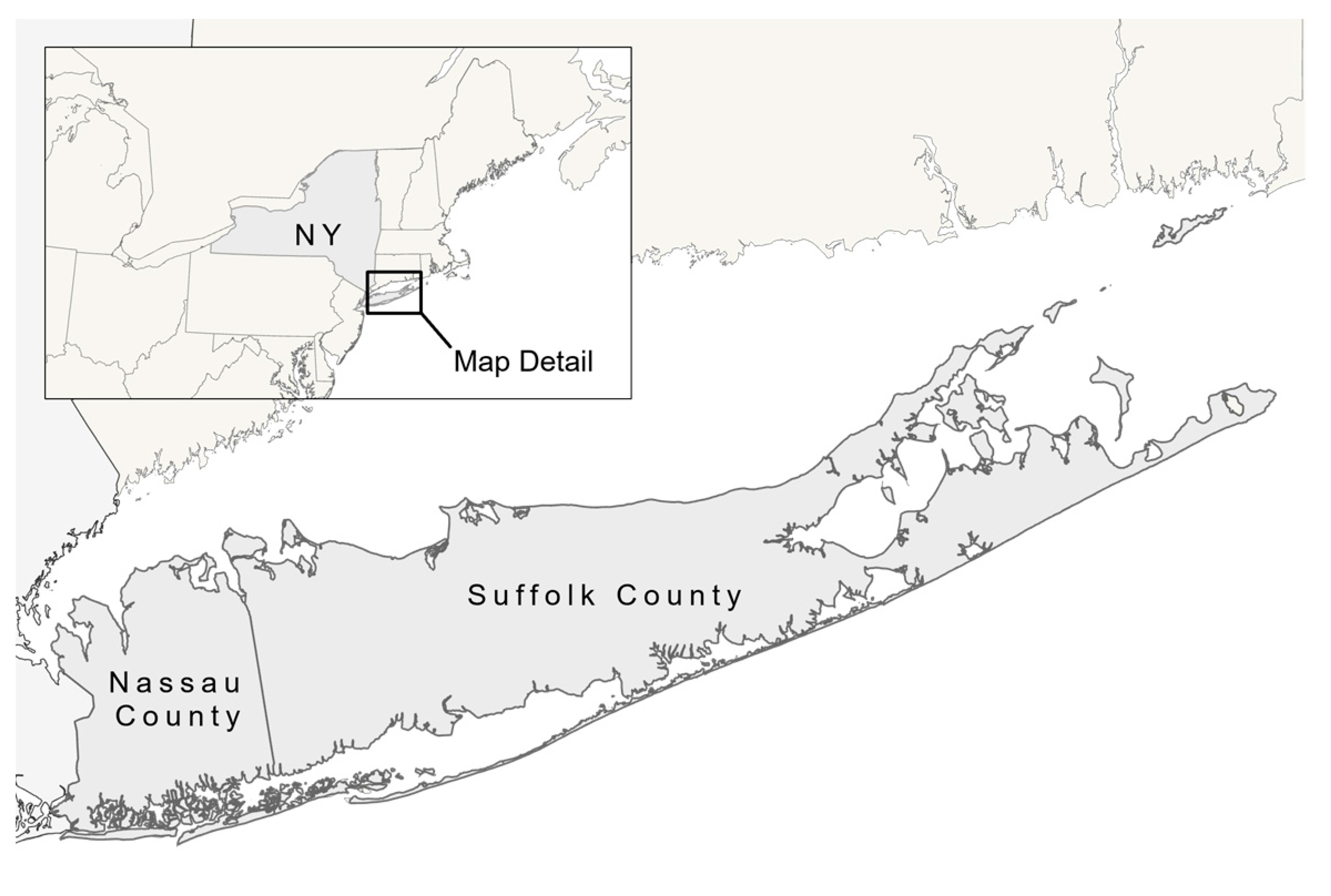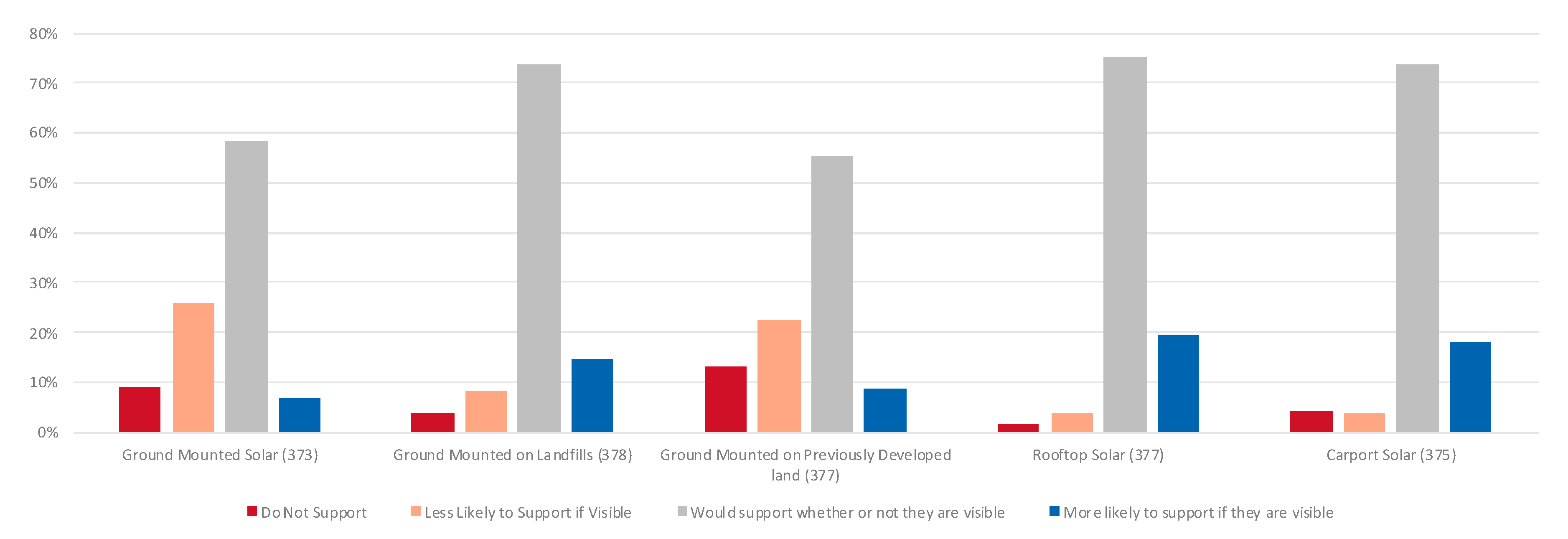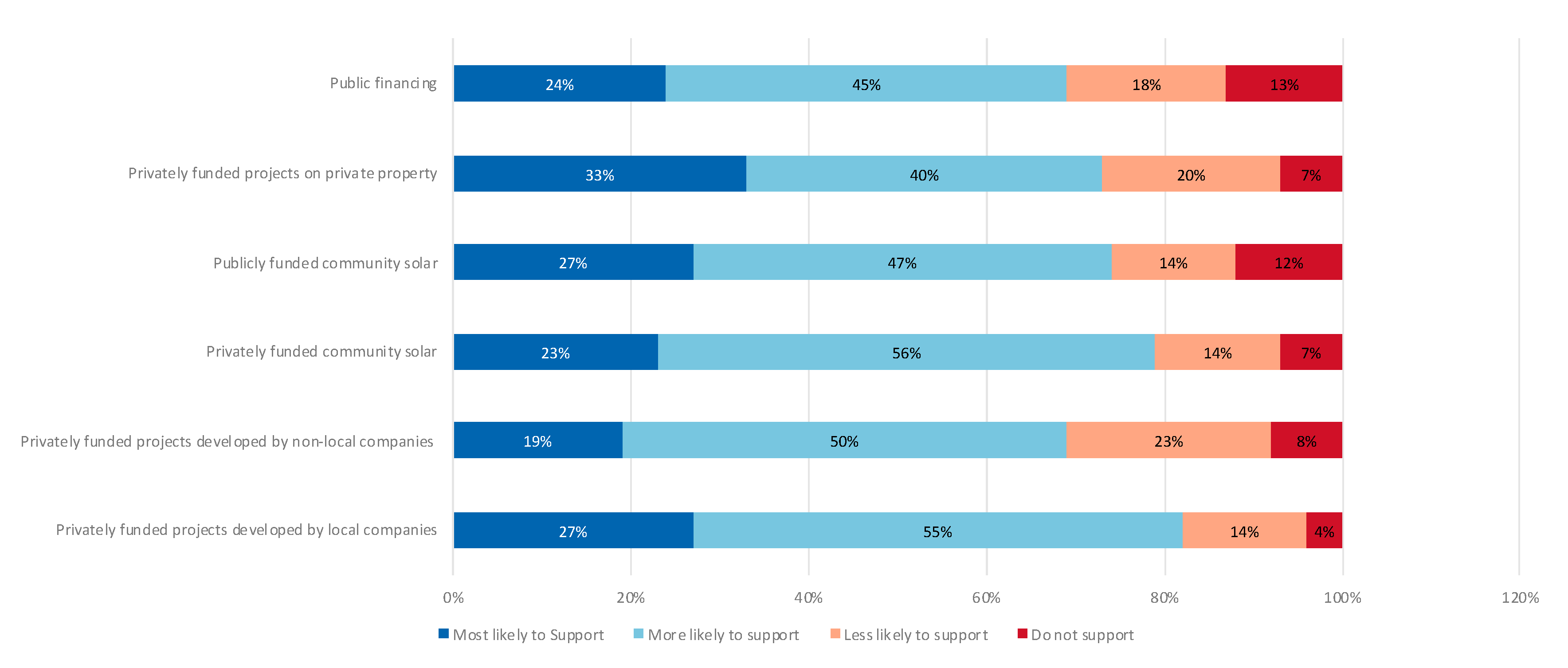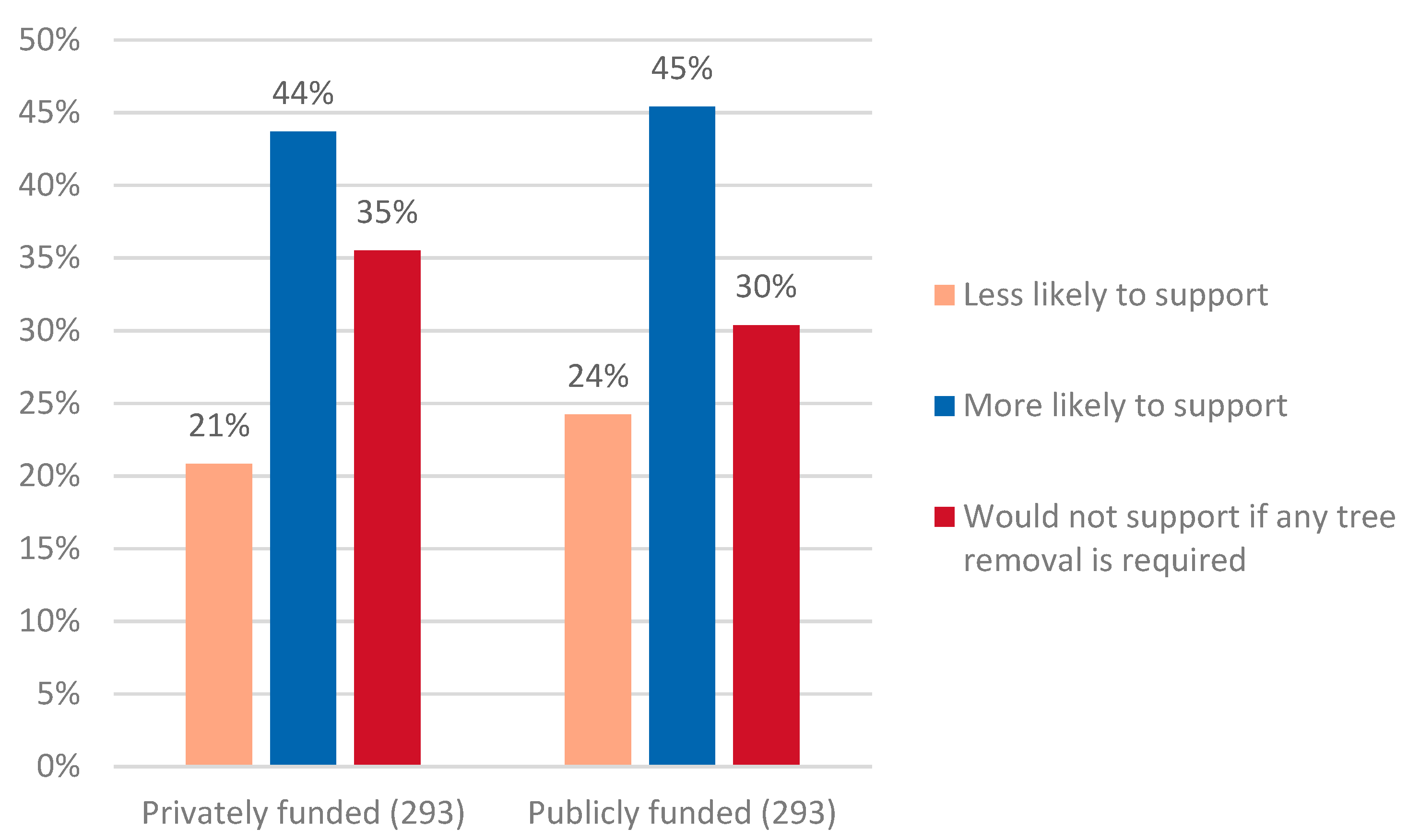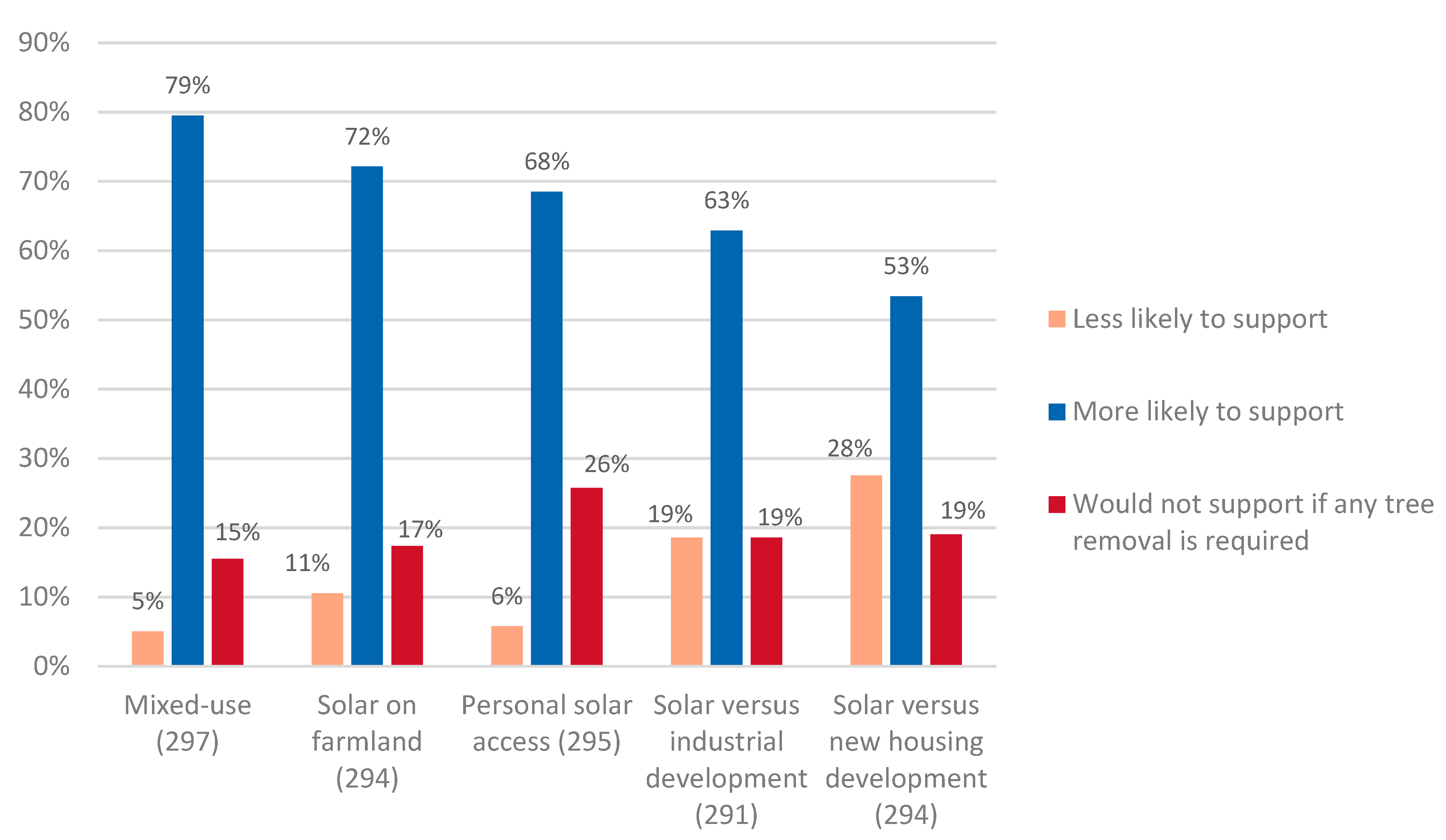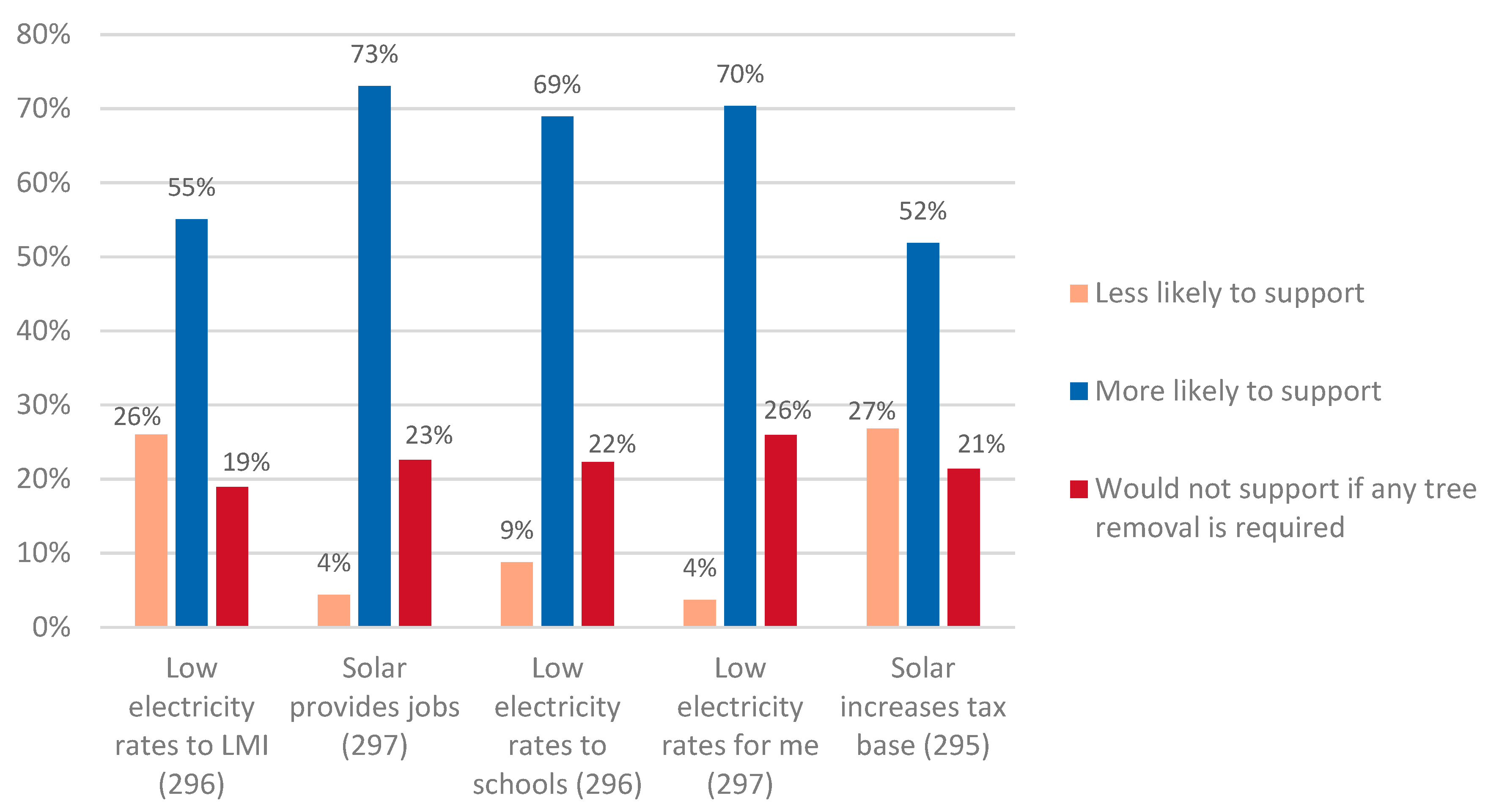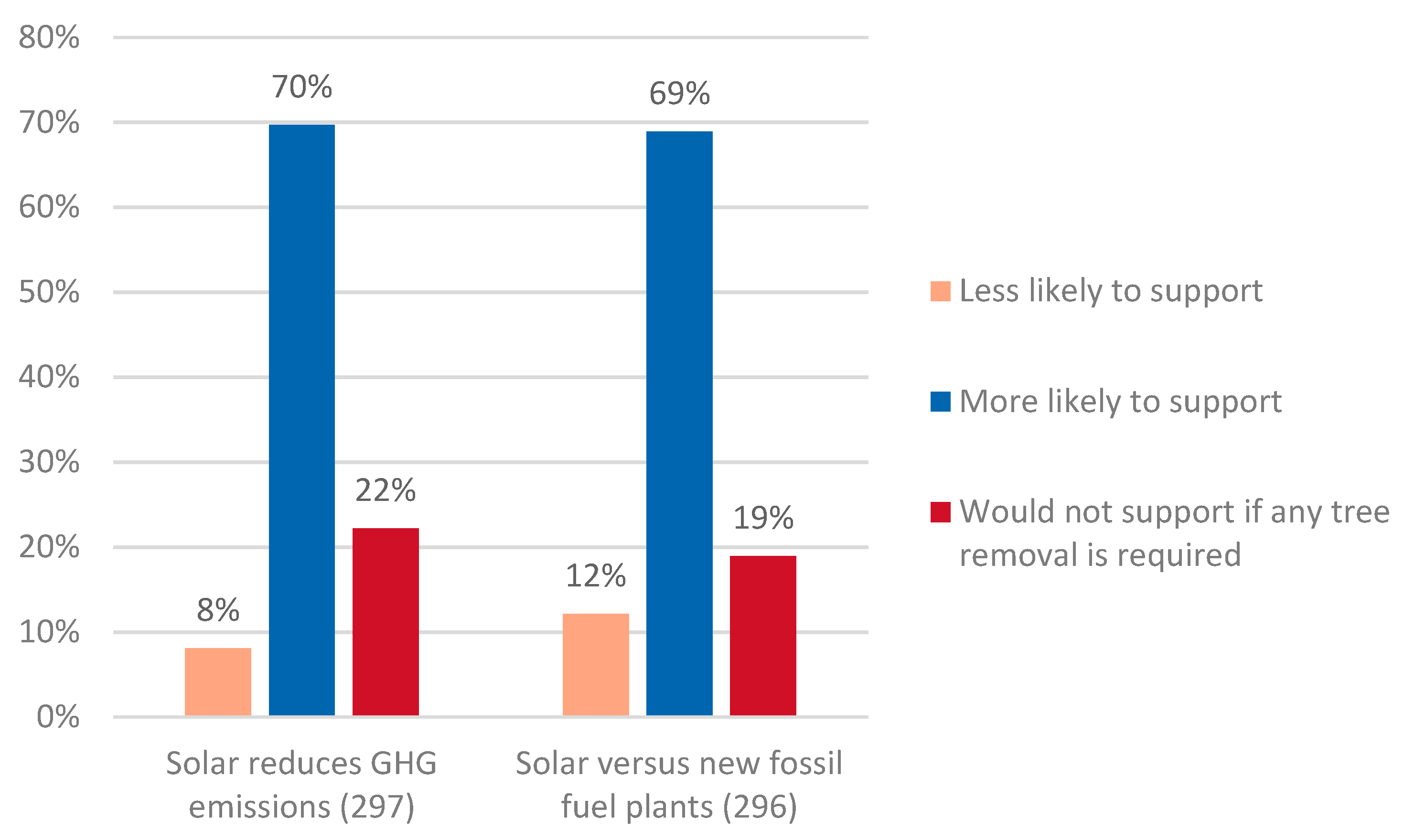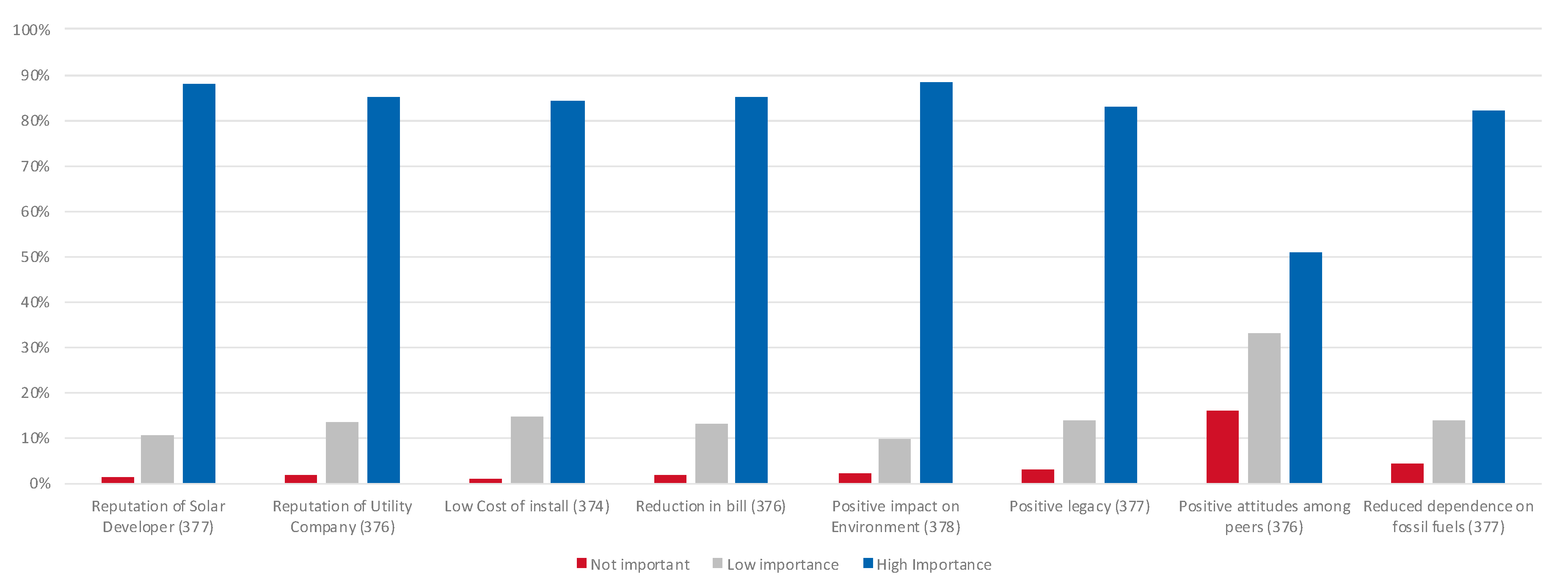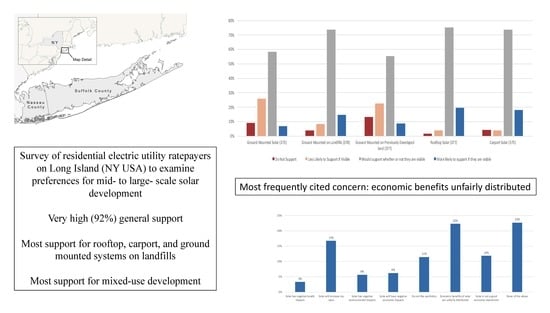1. Introduction
Solar electric technology (also known as photovoltaics or PV) is incredibly flexible in terms of installation size, location, and distribution of the energy produced. For example, small-scale, distributed solar systems can be located on a residential rooftop and deliver electricity directly to a home, while large, utility-scale systems can produce electricity for distribution of the electric grid. This study focuses on mid- to large-scale solar systems that are 250 kW in capacity or larger. Concerns over solar installations’ impacts to the local community and environment have led to growing conflicts over solar energy siting on Long Island, in other parts of New York, and throughout the US [
1]. Local opposition to solar and local restrictions on solar siting have the potential to significantly slow or even halt mid- to large-scale projects, which increases development costs and slows the transition to a carbon-free electricity sector.
In 2019, the state of New York (USA) adopted the Climate Leadership and Community Protection Act, aggressive legislation mandating that 70% of electricity consumed in the state is generated from renewable resources by 2040 and 100% from carbon free sources by 2050 (SB6599), motivated by the greenhouse gas (GHG) emissions reductions resulting from transitioning away from fossil fuels for electricity generation. Meeting this ambitious target will require development of new renewable energy generation at an unprecedented pace and scale. However, renewable energy development, both wind and solar, can be met with public opposition [
2,
3]. Although Long Island has a high rate of residential rooftop solar adoption (35% of all installations in NY State, NYSERDA 2018), large scale ground-mounted solar development projects have faced public resistance and conflict over siting and tree removal [
4,
5,
6].
A survey of residential electric ratepayers on Long Island was conducted to understand Long Island residents’ perspectives on mid- to large-scale solar energy development in their communities. This study is one part of the Long Island Solar Roadmap project (
http://solarroadmap.org/), a stakeholder-driven, collaborative project with the goal of identifying opportunities for accelerating the pace of solar development on Long Island. The project leadership team includes collaborators from The Nature Conservancy and Defenders of Wildlife as well as a social science researcher and a professional facilitator. The project involves engagement with a Steering Committee and larger Consortium group of stakeholders including professionals from the solar and utility industries, community and nonprofit groups, local governments, and others. The project’s approach integrates spatial analysis, economic research, and social science analysis to identify the locations and features of mid- to large-scale solar development that minimize environmental impacts and siting conflicts. The results are likely applicable to other space-constrained urban and suburban environments, and the project process provides insight for other entities interested in engaging stakeholders to better understand the social factors influencing solar energy siting and more effectively promote solar energy development [
7].
This paper first provides a review of relevant literature from previous research on public perceptions of solar energy development, highlighting particular research that has informed the approach taken in this work and the data analysis. The paper then presents the research methods used to conduct this survey before presenting the results from the survey data. The results demonstrate high levels of support for solar energy development on Long Island, with rooftop and carport solar installations being more highly supported than ground mounted systems. Preferences regarding other considerations in solar development, such as ownership, funding mechanisms, and tradeoffs, as well as perceptions of the risk and benefits of solar energy development, also provide valuable insights for promoting mid- to large-scale solar energy development that aligns with public preferences and avoids public concerns. The discussion and conclusion address study limitations and connect these findings to opportunities for engagement and future research to promote socially acceptable solar energy development.
2. Materials and Methods
The survey described here was developed as one part of a larger project examining the technical, economic, spatial, and social factors influencing mid- to large-scale solar development on Long Island with the purpose of providing information to promote development while reducing siting conflicts [
7]. This project involved stakeholder-driven processes and initial interviews and discussions with a diverse set of actors involved in solar energy development on Long Island. The survey questions, as well as the research questions driving data analysis, were developed through this stakeholder-driven process of engagement.
A survey of residential electric utility customers on Long Island was utilized to examine knowledge, preferences, and beliefs regarding mid- to large-scale solar energy development and the kinds of siting and financing choices involved in solar development planning. The survey was administered online by the local electric utility, one of the stakeholders that participated in this project, and sent to 50,000 randomly selected customer email addresses representing a utility service territory of approximately 1 million customers in Suffolk and Nassau Counties, New York (see
Figure 1). The survey was developed to be easily accessible on mobile devices and, at the request of the project team [
7], was developed with an English or Spanish language option, which respondents could select once entering the survey. The survey resulted in a total of 405 responses, six of which were responses to the Spanish language version of the survey, a total response rate of less than 1%. Given the population sizes of Suffolk and Nassau Counties (a total of 2,835,882 based on the 2010 Census), this sample size results in a 95% confidence level and a 5% margin of error. The survey was implemented by the local utility company via an online platform and researchers were only provided access to an anonymized dataset of responses to protect participant anonymity in compliance with best practices for human subject research involving private industry and University partnerships.
The survey introduction provided a size equivalent to help respondents visualize the size and scale of mid- to large-scale solar energy installations—solar systems 250 kW in capacity can be installed on as little as 0.7 acres, or the equivalent of half of a US football field. Survey questions asked about perceived knowledge of and general support for solar but focused mostly on examining preferences for solar development projects based on particular siting, financing, and other development considerations. The survey also asked about social factors that may influence support, perceptions regarding potential benefits and concerns, and reasons to support or oppose projects in respondents’ own community.
While respondent ages ranged from 18–70 or older, almost half of survey respondents reported ages 50–69. A larger portion of the survey respondents identified as male (43%) compared to female (28%; 29% no response). The largest response categories were from respondents reporting having attained either a Bachelors (24%) or Master’s (22%) degree. Over half (52%) of respondents reported identifying as White and only 4% identified as Hispanic or Latino. While more respondents identified with a Democratic (17%) compared to Republican (14%) political affiliation, the majority of individuals preferred not to report or did not answer (57%; 12% reported “Other”). As responses to these demographic questions were not required, these data are not being compared to Long Island demographics to consider representation to the general population.
3. Results
The survey asked respondents to rate their knowledge of solar. About half of respondents said they were knowledgeable or very knowledgeable (47%) and about half of the respondents reported a little knowledge or very little knowledge (53%). The survey also asked people about their perceptions of various issues related to climate change, renewable energy, and solar electricity generation. These questions were structured with response categories asking the extent to which people agreed or disagreed with these statements, based on a scale of strongly disagree, disagree, neutral, agree, strongly agree. Overall, survey respondents agreed that solar electricity generation has the potential to meaningfully contribute to energy production for their communities (83% agree or strongly agree), that renewable energy can meaningfully help to address climate change (82% agree or strongly agree), that it is every American’s responsibility to act to address climate change (79% agree or strongly agree), that solar energy is a good investment for local businesses (75% agree or strongly agree), and that solar energy specifically is needed to help address climate change (74% agree or strongly agree). When asked, “Generally speaking, do you support solar energy development in your community?”, respondents were overwhelmingly supportive, with 92% of respondents expressing general support.
Respondents were asked about their perceptions of five specific development types for mid- to large-scale solar development: ground-mounted arrays, ground-mounted arrays on landfills, ground-mounted arrays on previously developed land, rooftop arrays, and parking lot (carport) arrays. Overall, the majority of respondents support all five installation types in their community whether or not they would be visible from nearby roads or houses. Rooftop, parking lot, and ground-mounted solar arrays on landfills received the highest levels of support, each with 74–75% of respondents reporting support whether or not the system is visible from roads or houses in their community (see
Figure 2). For solar systems on rooftops, parking lots, and landfills, support increased for systems visible from the road. However, visibility reduced support for ground-mounted solar not located at a landfill, suggesting that the type of land use being replaced by a ground-mounted array matters for shaping public perceptions.
Respondents were asked about six different types of solar development: privately funded projects developed by local companies, privately funded community solar, publicly funded community solar, privately funded projects on private land, privately funded projects developed by non-local companies, and public (municipal) financing. Respondents were generally supportive of all funding models for solar development in their community (see
Figure 3). The most highly supported financial models for solar development included private funding by local companies and private funding of community solar projects. While respondents also reported support for projects that are privately funded by national or international level companies, local companies received higher support. Public financing received lower levels of support; in the survey text (see
Supplementary Materials), public financing was defined in terms of municipal funding (and consequently municipal ownership of the solar project). This suggests that respondents care about projects that create impact at a community level yet are more supportive of privately funded projects, although publicly funded community solar projects received higher levels of support than privately funded projects on private property or privately funded projects developed by non-local companies.
Table 1 summarizes the responses regarding preferences among financial models for solar development when organized into bivariate response categories of those who are “more likely” and “most likely” to support a particular model and those who “do not support” or are “less likely” to support a particular model. When categorized in this way, the most highly supported financial models are projects privately funded by local companies (82% support), private funding for community solar (79% support), public funding for community solar (74% support), and privately funded projects on private property (73% support), while the least preferred financial models are public, municipal financing (69% support) and privately funded project developed by non-local companies (69% support). However, it is clear that the majority of respondents are in favor of solar development regardless of the financial model, as variation in response is quite low and all options receive majority support. The purpose of providing these data in two forms (
Figure 3 and
Table 1) is to demonstrate that the more highly supported forms of solar development project are consistent across forms of aggregation, but when divided as a bivariate, public financing receives support equal to privately funded project developed by non-local companies.
Respondents were most supportive of privately funded projects developed by local companies and privately funded community solar. Community solar, also called community-shared solar or community-distributed generation, enables multiple customers, or off-takers, to receive the benefits of energy produced by a single solar system. There are two main models of community solar in New York, the purchase model and the subscription model. In the purchase model, individual customers decide how many panels in a community solar system they would like to own and pay the upfront cost for the panels. The panels provide power to the grid, and each customer receives credits on their electricity bill for the electricity their panels produce. Eventually, the savings they receive from those credits add up to more than their initial payment, allowing for a return on their investment. Under the subscription model, a sponsor designs, builds, owns, and operates the solar system, and interfaces with customers and the utility to ensure energy is properly allocated and billed. Energy from the system is delivered directly to the grid, and that energy can be credited to multiple subscribing customers. Public, municipal funding for community solar development was the second most supported financial model. In this scenario, a municipality plays a role in developing community solar either by leasing municipally owned space on which a community solar project is built or building and owning the community solar array to which residents can subscribe.
The next most supported financial models for solar energy development were privately funded projects on private property, privately funded projects developed by non-local companies, and public financing. Overall, respondents were generally supportive of all funding models, with even public financing receiving 69% “more” or “most” likely to support. However, public financing and publicly funded community solar received the highest levels of “do not support” (13% and 12%).
One specific survey item asked, “If solar development were to occur in your community, would these factors change your support for the project?” These response items were intended to examine preferences among the various decisions, trade-offs, and options involved in solar energy development projects and planning. Respondents were, overall, likely to support solar development with respect to all provided factors. The highest reported support was for solar projects that are co-located with other land uses (mixed use) at a particular site (79% more likely to support), followed by solar providing jobs (73% support) and solar projects on farmland that provide additional income for farmers (72% support).
Table 2 lists all factors in descending order of support. Tree removal was a more prevalent issue for privately funded (35% would not support if any tree removal is required) and publicly funded solar development (30% would not support if any tree removal is required), development intended to lower electricity rates (written on the survey as “lower electricity rates for me,” 26% would not support if any tree removal is required), and development intended to provide personal access to solar (26% would not support if any tree removal is required).
Overall, these responses regarding preferences in response to the various decisions and tradeoffs involved in solar energy development projects suggest that the majority of respondents support solar energy development across all provided decision categories. These factors can be grouped into four categories: financing, economics, environment, and siting (
Figure 4,
Figure 5,
Figure 6 and
Figure 7). Survey factors including private and public funding were separated out as financing factors. Factors such as mixed use, solar on farmland, personal solar access, solar versus industrial development, and solar versus new housing development were separated into siting factors. Survey factors such as solar that lowered electricity rates for low- to moderate-income households (LMI), solar that provides jobs, solar that lowers electricity rates to schools, solar that lowers personal electricity rates, and solar that increases a tax base were included in economic factors. Finally, solar that reduces GHG emissions and solar versus new fossil fuel plants were included as environmental factors. Respondents reported decreased support for answers that are framed in terms of funding (privately versus publicly funded solar) compared to other scenarios. Slightly fewer respondents opposed projects that require tree removal if they are publicly funded (30%) than privately funded (35%).
Figure 4,
Figure 5,
Figure 6 and
Figure 7 report on surveys questions that did not force respondents to provide a response, so the number of responses for these questions is lower than the total number of survey respondents.
The most important driver of solar support in terms of siting decisions appears to be solar that is developed as a mixed use project—that is, when solar projects are co-located with other land uses such as parking lots or agricultural production. Additionally, respondents care about the ability to provide supplemental income to farmers. Slightly less highly ranked in terms of preference were solar energy development projects that increase personal access to solar energy, solar development in place of strip mall development, and solar projects over industrial development projects. The lowest driver of support in the siting category is solar versus new housing development. Respondents were also asked to respond regarding their preferences for how potential economic benefits of solar energy development are distributed. The results suggest that respondents care about economic drivers such as whether solar energy development projects provide jobs to their communities and are supportive of solar energy development projects that reduce electricity costs for schools and for the respondent. The factors with the lowest levels of support in this category are low electricity rates to LMI houses and solar increasing tax base. Environmental motivations and benefits associated with reducing fossil fuel usage and GHG emissions are also drivers of support.
Two questions explored respondents’ perceptions of benefits and concerns regarding solar development in their communities. The first question, asking respondents to select all applicable benefits or reasons for support, elicited a total of 1320 responses among the 394 respondents who provided responses (only 11 respondents selected “none of the above”). Percentages are reported as a function of total number of responses to this question. Environmental benefits on both a local and larger scale were viewed as the greatest benefits or reasons to support solar development, followed by economic benefits to the ratepayer and a decrease in electricity rates (
Figure 8). The second question, also in “select all” format but regarding concerns, elicited a total of 516 responses among the 287 respondents who provided a response (118 respondents selected “none of the above”). The top reported concerns with solar development was a perception of solar economic benefits that are unfairly distributed (
Figure 9).
Respondents were also asked about factors that would influence or motivate their support for solar, based on factors found to be prevalent in the existing literature on motivations for solar adoption. Approximately half of respondents reported that perception of their peers is important in shaping their support for solar energy, the lowest ranked among the factors listed, with every other factor being important to at least 80% of respondents (see
Figure 10). These factors include reputation of solar developer, reputation of utility, low cost of installation, reduction in their electric bill, positive impact on the environment, leaving a positive legacy for future generations, and reduced dependence on imported fossil fuels.
A comparison of means test was used to explore differences between different groups regarding demographic characteristics (age, gender, education, income, race, and political affiliation) and general support for solar energy development on Long Island. This test determined whether there are any statistically significant differences between the means of different groups. These tests should be evaluated cautiously, given that respondents were not required to answer these questions, and so respondents that did not provide responses cannot be included in these analyses and may themselves have significant differences from other respondent groups. However, this test does suggest specific groups were statistically significantly different. A post hoc analysis was used to determine which groups were significantly different. There were no significant differences among demographic information and support for solar energy development.
Table 3 and
Table 4 illustrate the comparison of means between demographic characteristics and development types and financial models, respectively.
Table 3 illustrates significant differences in means and different development types. This table illustrates that the difference in means between age groups and ground mounted on previously developed land was significant. The post hoc test revealed that age groups 50–59 reported significantly higher support of ground-mounted solar on previously developed land compared to the age group 70 or older. The difference in means between income and ground mounted, ground mounted on previously developed land, and parking lot solar was significant. A post hoc analysis showed significant differences between means in income groups. Income groups USD 0 to 50,000 and USD 50,001 to 100,000 reported significantly higher support for ground-mounted solar than USD 300,001 to 400,000. Income groups USD 100,001 to 200,000 reported significantly higher support for ground-mounted solar on previously developed land compared to USD 300,001 to 400,000 groups. Income groups USD 300,001 to 400,000 reported significantly lower support for solar over parking lots compared to USD 200,001 to 300,000. The post hoc analysis revealed income groups USD 300,001 to 400,000 reported significantly lower support for ground-mounted solar, ground-mounted solar on previously developed land, and parking lots compared to all income groups. Finally, females reported significantly higher support for ground-mounted solar on landfills compared to males. All
p-values were below 0.05. All other mean comparisons for demographic characteristics and development types were insignificant.
A second analysis of variance was conducted with different financial models (
Table 4). A significant difference existed between political affiliation and support for public funding for solar and public funding for a community solar project. A Tukey post hoc test revealed that the level of support for public financing and public financing for community solar was significantly higher for Democrat versus Republican respondents and Other respondents.
4. Discussion
The results from the Long Island Solar Roadmap ratepayer survey indicate high overall public support (92%) for solar development. Respondents largely agreed that solar electricity and renewable energy more generally can make meaningful contributions to energy production for their communities and are necessary for addressing climate change, that it is every American’s responsibility to act to address climate change, and that solar energy is a good investment for local businesses. The results also demonstrate that understanding the dynamics of public perception and public support or opposition to mid- to large-scale solar development projects cannot be based on visibility considerations alone or anchored to a conceptualization of resistance as motivated by NIMBY attitudes, as this term erases the nuance in how people perceive and respond to various types of renewable energy development based on siting, financing, and other factors.
Instead, this research demonstrates that other considerations regarding the nuances of development decisions matter. The most highly supported types of solar development among surveyed Long Islanders were installations located on rooftops, parking lots, and landfills; solar co-located with other land uses (mixed use); mixed use sites that provide additional income for Long Island farmers; and community solar projects. These results demonstrate that respondents prefer projects that support the local economy and provide multiple benefits through mixed use development. Respondents did not express strong concerns about visibility and did not appear to be motivated by personal benefits or impacts (as they are more resistant to tree removal for projects that result in lower electricity rates for themselves). However, respondents did express concerns that the economic benefits of solar development are unfairly distributed. The economics of solar development are certainly complex, and the survey response item did not provide an opportunity for respondents to expand on these concerns. However, open-ended comments provided in the survey indicated that concerns center on utility companies benefiting financially without passing benefits on to consumers, or even benefiting financially from solar development while also raising rates for consumers to support solar development.
This survey was developed through a stakeholder-driven process, arguably demonstrating that public perceptions and social acceptance are essential considerations in solar development planning that should be considered alongside technical and economic considerations. Future research on solar development should also consider social preferences as part of the solar planning process. Further, these findings suggest that concerns typically labeled as “NIMBY” such as resistance to visible solar energy systems or tree removal to install these systems are less salient than concerns associated with choices about land use and distribution of economic benefits. These findings can inform future conceptualizations regarding dimensions shaping social acceptance of renewable energy systems. Future research may also consider whether knowledge of solar is predictive of support, or particular forms of support, as this research demonstrates a clearly bimodal distribution regarding reported perceived knowledge on solar development but did not directly explore if perceived knowledge impacts reported perceptions.
Developers should consider these findings when siting, designing, and setting the business models for solar development projects. Developers, utilities, and community-level decision makers should consider these findings and develop communication tools that clearly and transparently explain how the economic benefits of solar development are distributed. Finally, researchers can utilize this work to examine how these findings compare across other forms of energy development.
This survey was limited in ways that could be overcome in future research. The sample size provided an adequate confidence level, but the low response rate may suggest response bias. Respondents may have stronger opinions about solar energy than other members of the sample who did not choose to respond; however, it is logical that respondents who felt motivated to respond may be strongly supportive or strongly opposed to solar development on Long Island, but the results do not suggest strong opposition. The survey did not require responses to most of the questions, a choice made in distribution that limited some analysis options (such as differences across locations). Using these survey results to guide focus groups or community meetings may provide a way to explore their significance more deeply.
Some recent work suggests that Americans are more supportive of wind energy development than solar energy development [
22]. However, it is important to note that the survey sample of respondents have wind energy facilities sited near their communities, suggesting more generally that people are more supportive of those renewable energy technologies they have experienced. This is supported by other research [
11] and suggests the importance of incremental renewable energy development spread throughout communities, because visibility and exposure appear to increase support. This is consistent with work on residential scale solar adoption, as communities that have residential rooftop solar installations tend to see increased rates of adoption [
23]; thus, intentionally sited development of mid- to large-scale solar may help to increase adoption in communities that are currently under-served by solar.
Previous research also suggests that proximity is just one potential factor and that land cover and current land use also matter [
12]. For Long Island ratepayer respondents, visibility reduces support specifically for ground-mounted solar not located at a landfill, suggesting that the type of land use being replaced by a ground-mounted array matters for public perceptions. Further, mixed use solar and solar on farmlands providing additional income to farmers were the most highly supported developed factors in this study, further evidence that land type and land use matter for shaping public perceptions and public acceptability of solar development.
This research suggests that resistance to solar development may be expressed by a vocal minority that is not representative of a broader public perception, and that it may be a wealthy minority raising opposition. Among these respondents, those reporting an annual income less than USD 100,000 report significantly higher support for ground-mounted solar than those making more than USD 300,000, and those making more than USD 30,000 reported significantly lower support for ground-mounted solar, ground-mounted solar on previously developed land, and solar on parking lots, compared to all income groups. Finally, females reported significantly higher support for ground-mounted solar on landfill sites compared to males, and those reporting Democratic party affiliation were statistically more likely to support community solar than those reporting affiliation with the Republican party.
